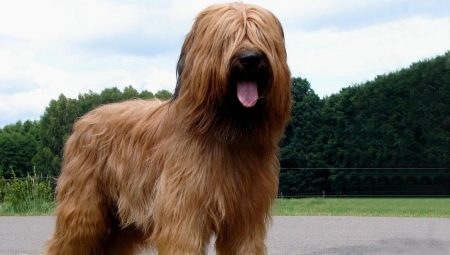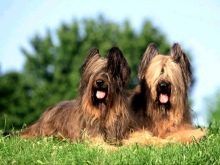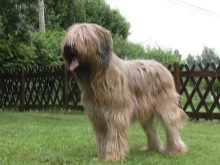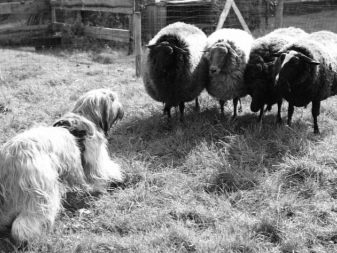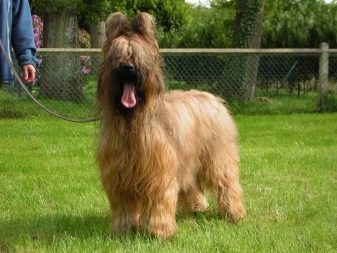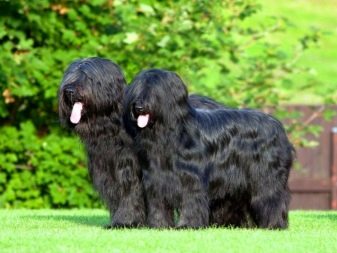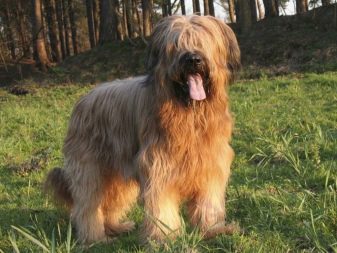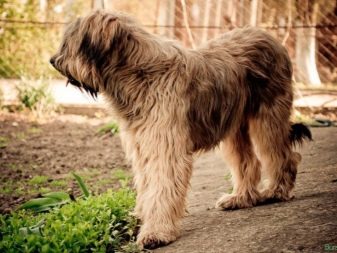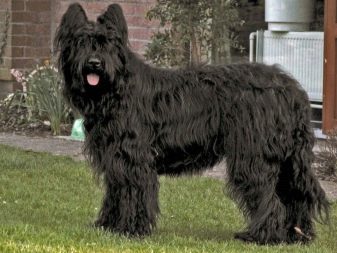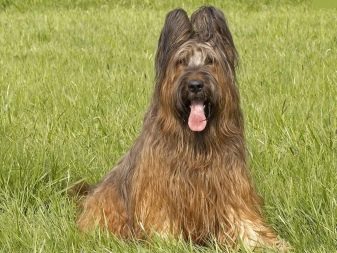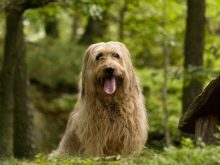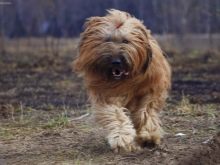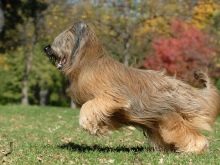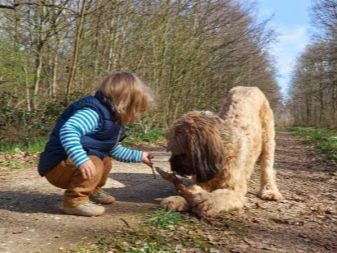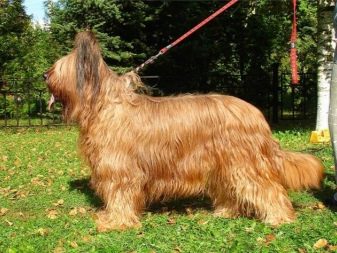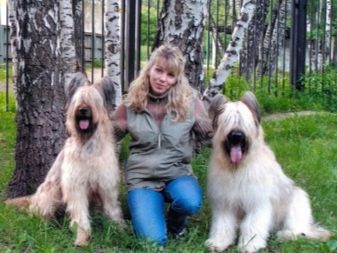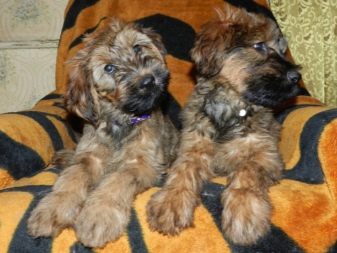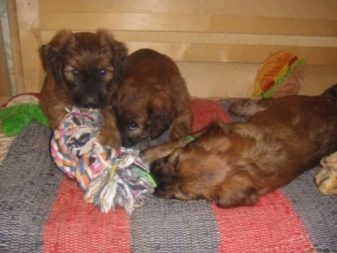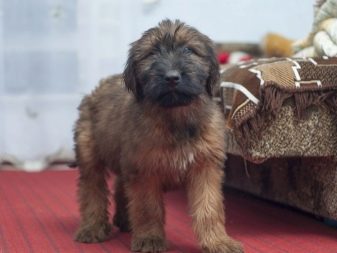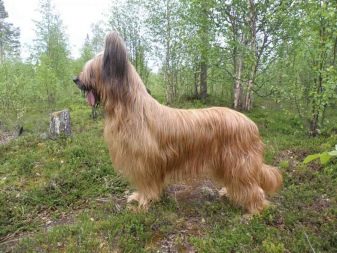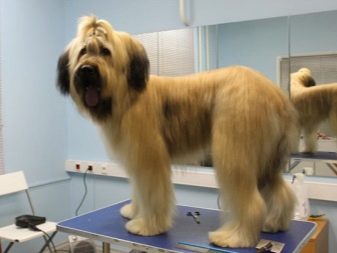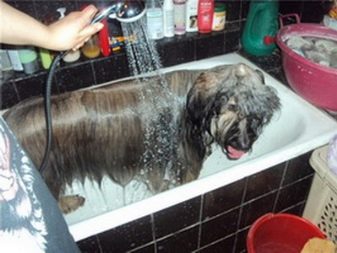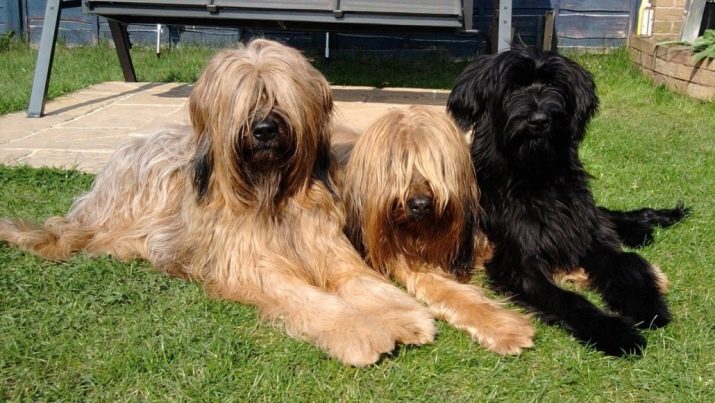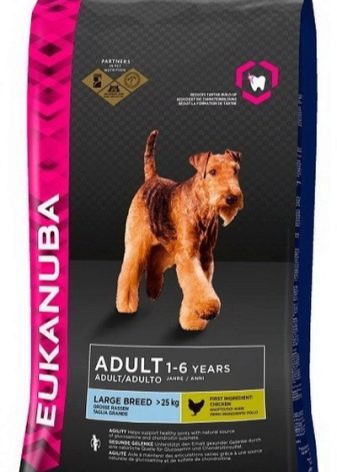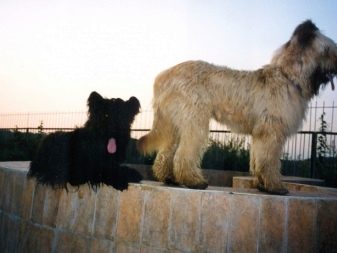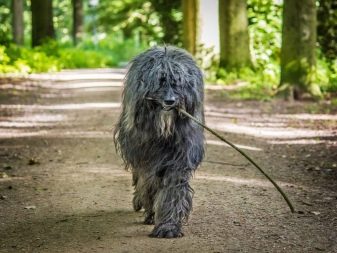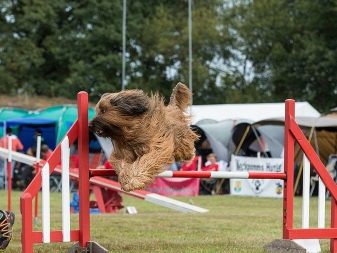Briard is a shepherd dog breed originally from France. This is the cleverest, industrious, bold creation that has become a faithful companion to man. The combination of large size and exterior decorative appearance attracts the attention of dog breeders around the world to briards.
History of origin
The Briar breed appeared in France in the 10th century and was known as the shepherd's French Shepherd Dog from Brie, because the province of the same name was considered the birthplace of dogs. Although shepherd dogs were common throughout France. A few years later, the first official description of a shepherd dog of funny appearance, covered with thick hair and an excellent herd keeper, appeared. Perhaps this applies not to the Briards themselves, but to their ancestors.
There is another option for the origin of the breed. Perhaps the forerunners of modern briards are Persian dogs. Their closest relatives are Beauceron, shepherd dogs. But, in addition to the purpose of grazing sheep and large size, they have little in common. Initially, the breed was actively used for the flock of sheep flocks.
So far, there is no reason to consider the Briards an artificially bred breed. Therefore, researchers have speculated that previously dogs were wildlife inhabitants. Proof of this is their ability to organize, gather a herd and the ability to live in a flock.
By the end of the 19th century, the breed did not have a certain standard, but as soon as it was established, dogs began to be regularly shown at exhibitions of international format. In the same period, the Briards were on the territory of the Russian Empire for further breeding. For some reason, breeding work with the breed has not gained popularity. But shepherd dogs were actively used at the front during the war. For the benefit of the army served their exceptional sense of smell and obedience. Briars were allowed in the footsteps of the soldiers, they searched for the wounded, bravely and deftly handed in ammunition during the shelling.
Many experts consider Briar a mix of barbet and Beauceron. The breed was first mentioned in writing in the 12th century. It was described in more detail in the XIV century in the handwritten work "Course on Agriculture" by Abbe Rozier.
In the XIX century. in France there were 14 varieties of purebred sheepdogs. In 1809, to designate a new breed, it was decided to call it the Briard shepherd.
Briar began his show career in 1863. And only in 32 years the Club of fans of the French shepherd was created. In 1897, an initial standard was written, describing two pedigree varieties: with wavy and straight coat.
The first type of wool was compared with sheep, and the second with goat. Briard with tight straight coat has become the predominant species. In 1988, the first amendments were made to the standard, after which the FCI (International Cynological Federation) recognized the breed. However, in 1995 it became known about the regular edition of the standard, which was recorded officially.
Today, briar does not shepherd sheep, and often lives in the family as a pet. Such a pet once accompanied Napoleon and lived in the house of Henry Lafayette. The shepherd’s breed is appreciated not only in France, but also throughout Europe, and in Switzerland such dogs serve on the staff of the Civil Defense units to help search for victims in the rubble (earthquakes, collapses, avalanches). In Sweden, dogs are generally recognized as representatives of breeds for training.
In his homeland Briar second place in the popularity rating.Breed concedes superiority only German shepherd.
Breed features
Pedigree shaggy dog differs in quite large size. The growth of a standard briar varies in the range of 58-69 cm. Earlier, the standard assumed to stop the ears of representatives of the shepherd's breed. The ears assumed a standing position and were triangular in shape. Today in European countries, a different description of the ears of these dogs is adopted: loosely hanging along the head, fleshy, completely covered with hair.
Like other service breeds, the weight of French briards of a strict standard does not have, the weight of males is about 30-45 kg, females weigh slightly less - 25-30 kg. The sheepskin coat of the shepherd’s breed dogs looks chic, even though the top coat is hard and coarse. Wool with soft curls covers the briar's body, sometimes lengthening (in the shoulders, the length may increase to 15 cm).
The undercoat is short and dense. Muzzle, thickly overgrown with hair. Briar's eyebrows "cover" the eyes with thick veil. According to the standard, excessive vegetation, when eyes are completely hidden, is an unacceptable phenomenon.
Briard can have a different color:
- redhead;
- the black;
- Gray;
- in variations of the listed colors.
The deeper the coat color, the better. For two-colored individuals, a smooth transition in tones with unique symmetry is characteristic. The standard does not pass spotty and white dogs. Separate whitish hairs or a small speck of white color in the sternum area are allowed.
Another interesting nuance regarding the color of a briar is that all puppies are born dark and brighten as they grow. Only at 3 years old, the dog's coat color becomes stable. In rare cases, the process is delayed for a longer period. This does not apply to black, since this color is unchanged from birth.
The eyes of the shepherd's dog are wide apart, they are black or dark brown. The look always looks inquiring. On the large face there is a big nose with a black lobe and wide nostrils. The lips are tight and feature black pigmentation.
Many breeders compare the soft, graceful gait of their four-legged pets with the cat. In fact, Briards move with ease, as if gliding. These are very mobile dogs capable of changing the trajectory of lightning speed or stopping while running.
Briar has a peculiarity inherited from Beauceron: on the hind limbs of dogs, instead of one, there are 2 dewclaws with bones and claws, that is, six-fingered paws.
Character and behavior
Dogs are distinguished by inquisitive temper, friendliness and devotion. Despite their decorative appearance, briards need emotional and physical stress. Otherwise, the dog becomes lethargic and apathetic. Briaru living in an apartment, you must provide the opportunity to often and long walk in the air.
The dog of the described breed is an excellent companion, but not for lying with the owner in front of the TV. She will be happy to support the owner in jogging, cycling and even in the heats. And without physical activity, the dog may become embittered.
Briaram for the full existence of a need to communicate with a person. Individuals of this breed are difficult to tolerate separation. Their level of socialization is so high that they easily adapt in unfamiliar places and among crowds.
Briards are happy to welcome guests and always “for” to play and have fun with adults and children. During the walk, Briar shows interest and takes care that none of the accompanying people lags behind the company. This behavior is typical of most sheepdogs.
Shepherd dogs are great travel companions, as they keep calm when traveling on different types of transport. The need to protect - in the blood of these shaggy shepherds.Despite the outward manifestation of fun, the dogs constantly monitor the movements of the household and all other members of the company.
It is important for owners of a briar to understand that a pet belongs to service breeds, therefore, an adult should be engaged in raising it. There is no need to impose dressage on children. Even if the dog communicates perfectly with the younger members of the family, it still needs to feel the authority of the host, who will deserve the respect of the dog. This is an important point, because growing dog will attempt to lead, wanting to climb to the top of the hierarchy. There is no way to allow such a situation.
A dynamic, agile dog is characterized by extreme endurance. The dog can tirelessly overcome 70-80 km daily. This exquisite runner is a maneuverable and obedient dog. It is a reliable, slightly dominant, mentally gifted dog.
Briard is less aggressive than the representative of the breed Beauceron and more affectionate to the owner. This French breed is powerful, but sensitive. Briard is called at home "the heart wrapped in furs." Teasing dogs is unacceptable, since in response they will surely show aggression.
The family in which they live, the Briards are sincerely devoted, they will never refuse to play with the children. But the kids need to be taught how to communicate with the dog so that the kids, through carelessness, do not hurt her.
A dog may be aggressive with other dogs. You also need to understand that by nature Briar is a shepherd dog, so he will fulfill this task with everything that moves. Some members of the breed do not tolerate cats, with the exception of those with whom they grew up. Instinctively, they seek to control other animals by pinching their legs, as their ancestors did in nature with sheep. In the city it is better to walk the dogs on a leash.
If a dog is frightened by nature or aggressive for no reason, then you will have to forget about dog shows with her. For such qualities Briards are subject to disqualification.
The educated representative of the breed is a wonderful pet. It is important for him to contact a person. This brings the dog a real puppy joy. Briard can safely start in a family where children grow up.
Despite their size, French briards are good-natured and quiet in nature. Therefore, it is comfortable to live with them even in a small apartment.
How to choose a puppy?
Breed Briard is not widespread in Russia. But There are nurseries in almost all major cities. So to get a puppy of a French shepherd dog in the Russian Federation is real and quite affordable. You will have to pay for a pet from 15,000 to 30,000 rubles (2019).
If you plan to breed Briards in the future, the price for a dog will be at least 25,000 rubles. For a reference puppy without flaws, the planned exhibitor breeders will ask for an amount in the region of 45,000 rubles.
It is better to acquire a shepherd puppy dog breed of three months of age, when he is fully mature and will receive all of the vaccinations.
The puppy's health is characterized by its wool, which normally should be radiant and pleasant to the touch. Stiffness appears a little later, as the pet grows. If the type of wool is dull, and when stroking a little dog there are hairs on the arm, it means that the puppy is deficient in vitamins, the baby's body is weakened.
To restore the health of such a dog to be thoroughly spent. And you need to be prepared for this. Otherwise, it is worth looking out for another puppy.
Another sign of probable problems is the apathy of the animal and its insecure, sometimes limping movements when moving. If there is no confidence in the knowledge of the breed standard, as well as that it will be possible to decide on the choice of a puppy, it is better to attract a specialist to the purchase. He will check the dog for possible defects and pathologies, clarify all information on vaccinations and check the documents for authenticity.
Briard is a great companion for dynamic hosts. He, as they say, is ready to follow the owner even to the ends of the earth, and he is not satisfied with trailing behind him, he will certainly be proud to keep pace with the man.
Maintenance and care
A dog must be provided with at least moderate activity daily. This need can be satisfied with a long walk or jogging. Every day you need to do exercises with a dog for at least half an hour, ideally - 60 minutes. If the mobility is not sufficiently secured, Briard can begin to harm, spoiling things. In addition to chewing things, dogs begin to bark for no reason and make digs in the area.
In addition to activity, Briard needs grooming. Wool in shepherd dogs is their property, naturally, its beauty and health must be maintained. Combing dogs has daily and long enough. The procedure sometimes takes about two hours. Thanks to this care, the dog's coat becomes shiny and smooth.
The advantage of keeping the briar in the house is the absence of seasonal moulting, so the wool throughout the house will not have to be cleaned.
If you do not plan to drive the dog to the exhibition, it is permissible to shorten the coat slightly. Such an approach minimizes problems and makes pet care easier. Professional grooming is necessary for the shaggy "shepherd" at least once every 2-2.5 months.
It is necessary to regularly wash the briar. At least once in 4 weeks and even more often when the dog got dirty. This applies only to apartment dogs, and briards living in aviaries are only enough to bathe a few times a year.
Another feature of the shepherd’s breed is that from the wet wool it comes not a dogish smell, but a sheep smell.
It is important to care for the ears, eyes and paws of shepherd dogs. They need to be carefully examined and promptly cleaned of dirt and dust. Thus, the prevention of infectious diseases. A large herding dog has a propensity for such diseases:
- dysplasia of the hip joint and elbow;
- congenital night blindness;
- hypothyroidism;
- retinal atrophy;
- von Willebrand disease;
- crayfish;
- torsion in the stomach.
Nutrition
Getting a large dog, it is important to realize that such a pet will eat a lot. This aspect needs special attention. Like most other breeds, briar can be fed with natural products or dry ready-made food.
But mixed pet food will not work. Moreover, it can adversely affect dog health. Briaru needs a balanced menu. The main food in the diet of a large dog - meat. Additionally, you can cook porridge: from vegetables (carrots, pumpkins), greens, cereals (millet, buckwheat, oatmeal).
You can not treat the dog potatoes, rice, pastries, confectionery products.
How much food to give depends on the weight of the dog and its activity. Briar has excellent digestion, so dogs of this breed do not suffer from indigestion. In hot weather, dogs become less active, so it is worth reducing the amount of protein in the diet, by introducing more vitamin E and yeast.
In addition, it is allowed to add a small amount of food peanut butter. If it was decided to feed the dog with industrial feed, you should make every effort so that it is the highest quality product (premium, and better super-premium or holistic). Dry food should be suitable for long-haired dogs.
If the pet lacks vitamins and trace elements, its wool responds immediately to a shortage of nutrients. Briar's coat dims, rolls, shines. And if the diet changes for the better, but the coat remains unkempt externally, it is necessary to consult with a veterinarian.
Upbringing and training
Briards are dogs with increased curiosity and pronounced intelligence. They are easy to teach teams but unless coarse methods are used, using demanding treatment without physical punishment. The pet will not mindlessly obey, it is characteristic of him to pre-ponder, rather than act unconditionally.
Since puppy period, it is necessary to socialize the pet intensively and extensively. He must be trained consistently, showing great patience and not showing cruelty, but only perseverance and moderate rigidity. Otherwise there will be no results, because without proper preparation it will be an angry and aggressive dog.
For a dog that has been trained, it is not a problem to wait quietly for the owner alone, for example, at the door of a supermarket or clinic. Most of the Briards demonstrate a balanced character, but among the representatives of the breed there are also extremely temperamental individualsthat just need special training courses for developing excerpts. Also found phlegmatic briarsbut extremely rare.
If you intend to have a pet competitor, Briar will be a win-win option. Instant response, agility, endurance and flexibility make it capable of dressing any type. He will be able to take a test course and lead on most regulatory requirements, including towing.
In addition, Briards are often noted as champions for external data.
For more on the features of the breed, see the following video.
